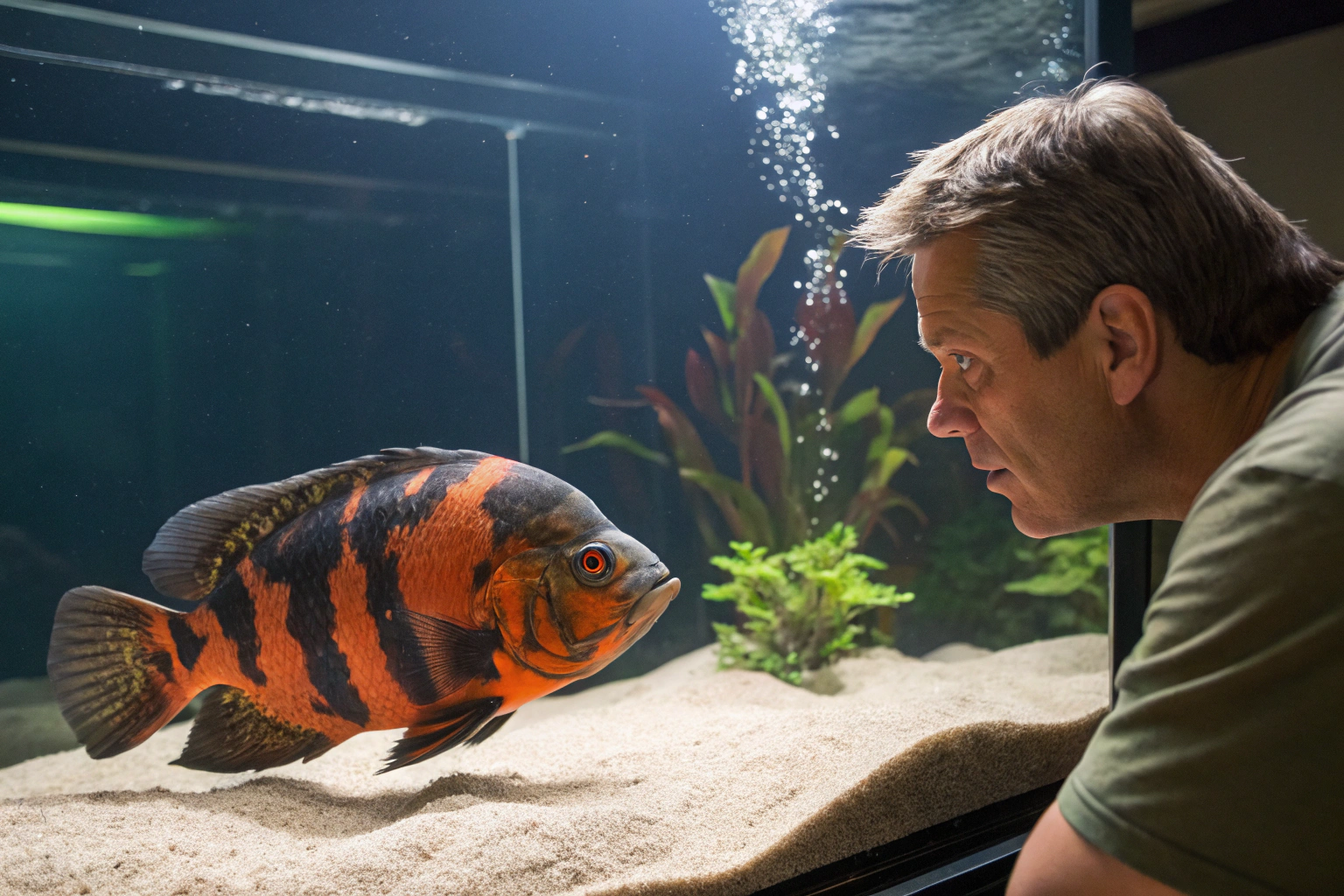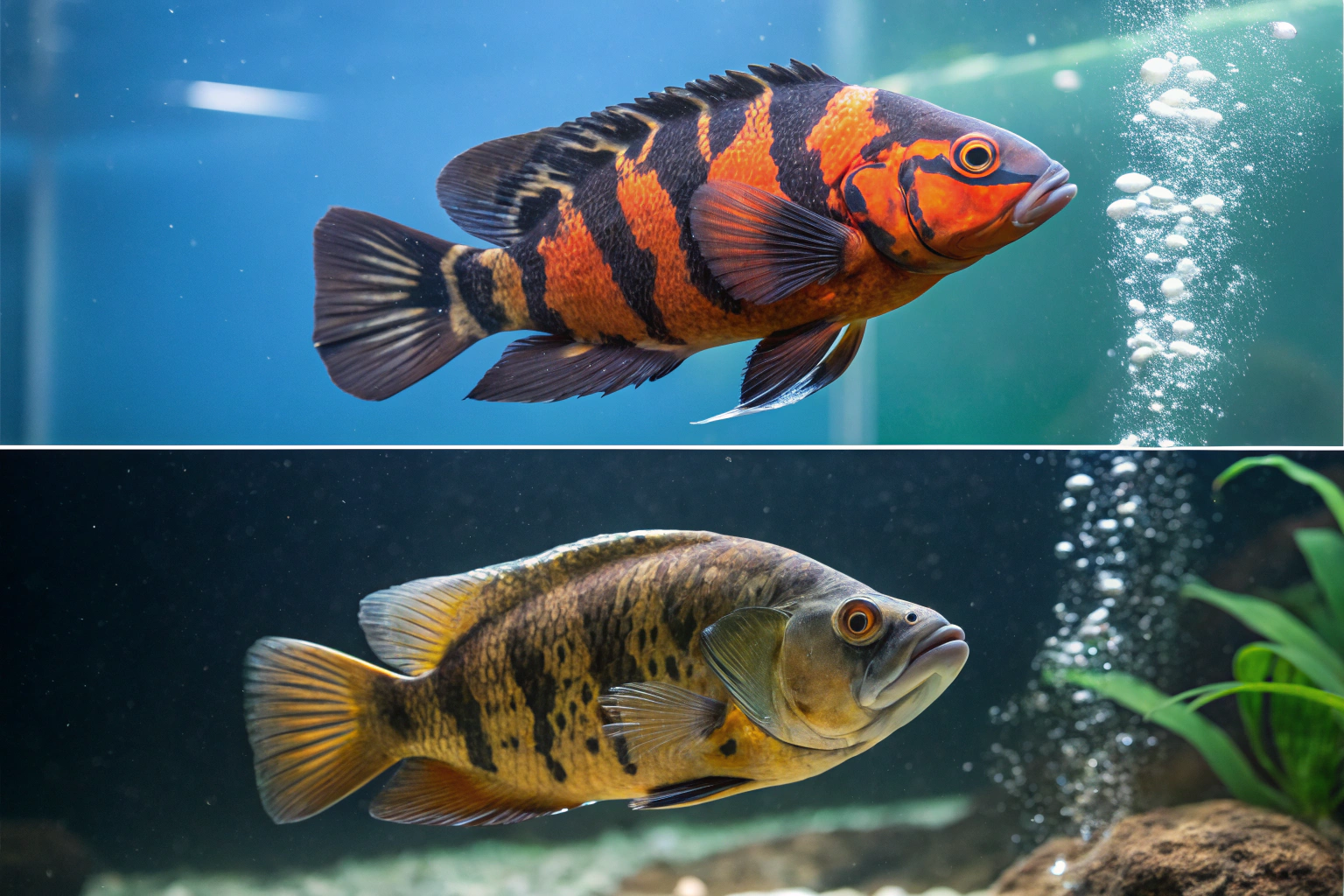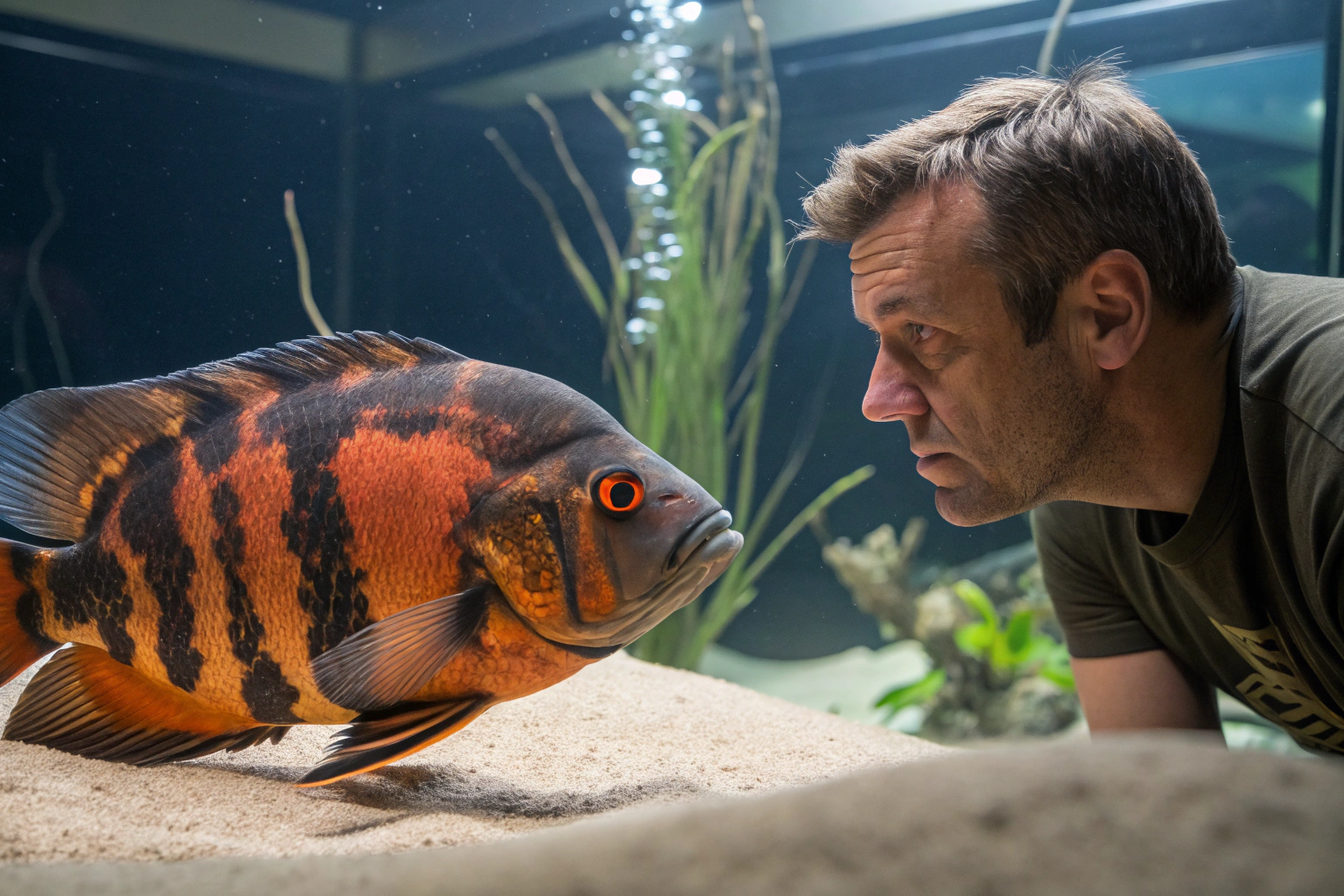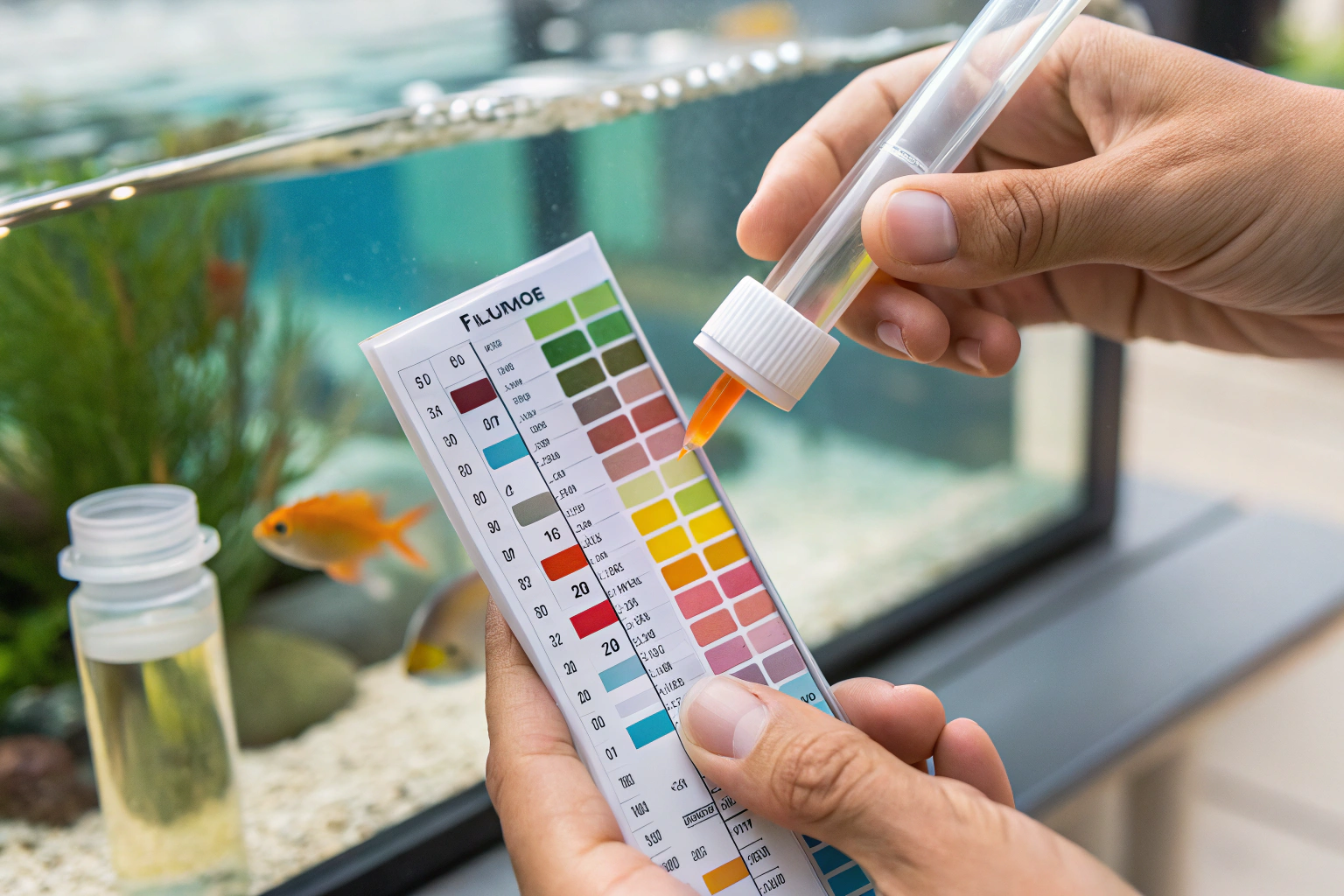Why Is My Oscar Fish Laying at the Bottom of the Tank? Expert Guide to Oscar Fish Health
This post may contain affiliate links.
If you’ve noticed your Oscar fish spending unusual amounts of time lying at the bottom of your aquarium, you’re right to be concerned. This behavior, while sometimes normal, can indicate serious health issues that require immediate attention. As one of the most intelligent and interactive freshwater fish species, Oscars typically exhibit active swimming patterns throughout all levels of the tank.

Understanding Normal vs. Abnormal Oscar Fish Behavior
Oscar fish (Astronotus ocellatus) are naturally active swimmers that should utilize the entire vertical space of their aquarium. These South American cichlids are known for their curious nature and tendency to interact with their owners. When an Oscar consistently remains at the bottom of the tank, it’s displaying what aquarists call “bottom sitting” behavior.
When Bottom-Sitting Is Normal
Before panicking, understand that Oscars may rest at the bottom during:
- Nighttime hours – Like most fish, Oscars have sleep cycles
- After feeding – Heavy meals can cause temporary lethargy
- During breeding season – Females may rest more frequently when carrying eggs
- Temperature fluctuations – Minor environmental changes can cause temporary behavioral shifts
Primary Causes of Oscar Fish Laying at Tank Bottom
1. Poor Water Quality – The Most Common Culprit
Water quality issues account for approximately 80% of Oscar fish health problems. These large fish produce significant bio-load, making them particularly sensitive to:
- Ammonia buildup (should be 0 ppm)
- Nitrite spikes (should be 0 ppm)
- High nitrate levels (should be below 20 ppm)
- pH imbalances (ideal range: 6.0-8.0)
Solution: Test your water immediately using a reliable aquarium test kit. Perform a 25-30% water change if parameters are off, and increase your maintenance schedule.
2. Temperature Stress
Oscars require stable temperatures between 74-81°F (23-27°C). Temperature fluctuations of more than 2-3 degrees can cause:
- Weakened immune system
- Digestive problems
- Lethargy and bottom-sitting behavior
Solution: Install a quality aquarium heater with a backup system and monitor temperature daily.
3. Swim Bladder Disease
This common condition affects the fish’s ability to maintain buoyancy. Symptoms include:
- Difficulty swimming upward
- Floating sideways or upside down
- Remaining at tank bottom
- Loss of appetite
Solution: Fast the fish for 24-48 hours, then feed blanched peas. Consult with an aquatic veterinarian if symptoms persist.
4. Inadequate Tank Size
Oscars require minimum 75 gallons for a single adult, with 100+ gallons being ideal. Cramped conditions lead to:
- Chronic stress
- Territorial aggression
- Poor water quality
- Behavioral abnormalities
5. Nutritional Deficiencies
Poor diet can cause numerous health issues. Oscars need:
- High-quality pellets as staple food
- Variety including frozen/live foods
- Proper feeding schedule (2-3 times daily for juveniles, once daily for adults)
- Foods rich in vitamins A, C, and E

Disease-Related Causes
Hole-in-the-Head Disease (HITH)
This serious condition, linked to poor water quality and nutrition, causes:
- Visible pits around the head and lateral line
- Loss of appetite
- Lethargy
Internal Parasites
Signs include:
- White, stringy feces
- Bloated appearance
- Reduced activity
- Loss of coloration
Bacterial Infections
Often secondary to stress or injury:
- Fin rot
- Body lesions
- Rapid breathing
- Bottom-sitting behavior
Immediate Action Steps
Emergency Assessment (First 30 Minutes)
- Test water parameters immediately
- Check temperature stability
- Observe for additional symptoms (breathing rate, coloration, appetite)
- Remove any tank mates if aggression is suspected
Short-Term Solutions (24-48 Hours)
- Perform water change (25-30% with dechlorinated water)
- Increase aeration to boost oxygen levels
- Reduce feeding to minimize waste production
- Monitor closely for behavioral changes

Long-Term Prevention Strategies
Water Management:
- Weekly 20-25% water changes
- Monthly deep substrate cleaning
- Regular filter maintenance
- Quality filtration system rated for 2x your tank volume
Nutritional Optimization:
- Feed high-quality Oscar-specific pellets
- Supplement with frozen bloodworms, brine shrimp
- Include vegetable matter (blanched peas, zucchini)
- Avoid overfeeding – feed only what fish can consume in 2-3 minutes
When to Seek Professional Help
Contact an aquatic veterinarian or experienced aquarist immediately if you observe:
- Rapid breathing or gasping at surface
- Visible lesions, wounds, or unusual growths
- Complete loss of appetite for 3+ days
- Dramatic color changes
- Abnormal swimming patterns beyond bottom-sitting
Tank Setup Optimization for Oscar Health
Essential Equipment Checklist:
- Filtration: Canister filter rated 6-10x tank volume
- Heating: Redundant heating system with temperature controller
- Lighting: LED fixtures with day/night cycle
- Substrate: Fine sand or bare bottom for easy cleaning
- Decorations: Smooth, Oscar-safe ornaments without sharp edges
Water Quality Monitoring:
Invest in quality testing equipment from reputable manufacturers like API or Salifert. Test weekly for:
- Ammonia
- Nitrite
- Nitrate
- pH
- General hardness (GH)
- Carbonate hardness (KH)
Recovery Timeline and Expectations
With proper intervention, most Oscar fish recover from bottom-sitting behavior within:
- Water quality issues: 24-72 hours after correction
- Temperature stress: 12-24 hours with gradual adjustment
- Minor illness: 3-7 days with appropriate treatment
- Serious disease: 2-4 weeks with veterinary care

Prevention: The Best Medicine
Maintaining optimal Oscar fish health requires consistent attention to:
Daily Tasks:
- Visual health inspection
- Temperature monitoring
- Feeding appropriate amounts
Weekly Tasks:
- Water parameter testing
- 20-25% water change
- Equipment inspection
Monthly Tasks:
- Deep tank cleaning
- Filter media replacement/cleaning
- Equipment calibration

Conclusion
Oscar fish laying at the bottom of their tank is a serious behavioral indicator that demands immediate attention. While sometimes caused by minor environmental factors, this behavior often signals underlying health issues requiring prompt intervention. By maintaining excellent water quality, providing proper nutrition, and creating an optimal environment, you can prevent most causes of this concerning behavior.
Remember that Oscars are intelligent, long-lived fish that can thrive for 10-15 years with proper care. When in doubt, consult with experienced aquarists through reputable forums like FishLore or seek advice from aquatic veterinarians through the Association of Aquatic Veterinarians.
Your Oscar’s health depends on your vigilance and quick response to behavioral changes. With the information provided in this guide, you’re now equipped to identify, address, and prevent the common causes of bottom-sitting behavior in Oscar fish.
For more comprehensive aquarium care guides and expert advice, visit leading aquascaping resources and connect with the broader fishkeeping community. Remember: a healthy Oscar is an active, interactive Oscar that brings years of joy to dedicated aquarists.
